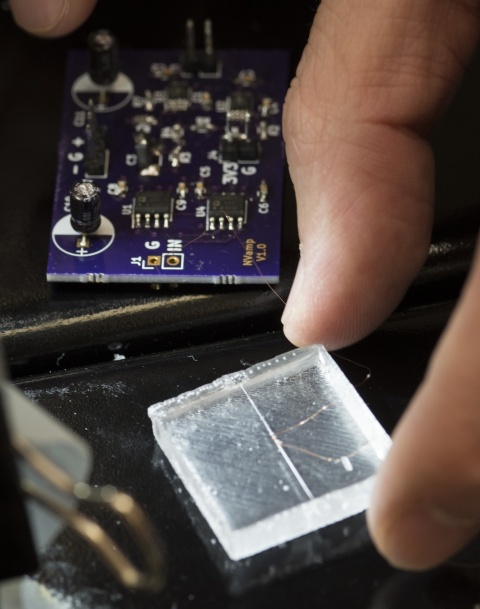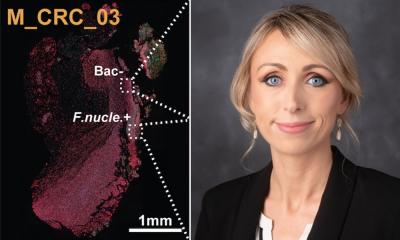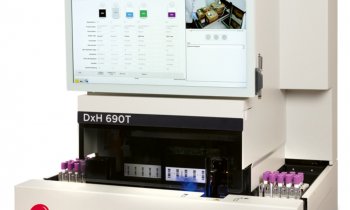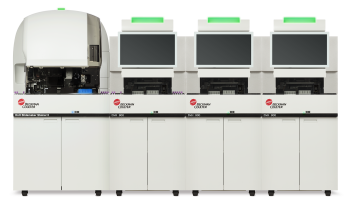News • Equipment
A tiny, more cost-effective white blood cell counter might be available soon
A thin copper wire wrapped around a channel slightly thicker than a strand of hair could be the key to manufacturing a compact electronic device capable of counting white blood cells from the comfort of one’s home, a Kennesaw State University researcher says.
If we can focus on one thing – counting cells – we can make something smaller and more affordable for both the patient and the provider
Hoseon Lee
Hoseon Lee, an assistant professor of electrical engineering in the Southern Polytechnic College of Engineering and Engineering Technology, and his team of six students have spent the past year researching more efficient ways for patients receiving chemotherapy to monitor their white blood cell count without the frequent, and sometimes costly, visits to the hospital. Cancer treatments often lead to lower white blood cell counts and an increased risk for infection, therefore requiring regular testing to measure levels, according to the Mayo Clinic.

To monitor white blood cell levels, many clinics currently use a method called flow cytometry, Lee said. The process works by dying cells a fluorescent color which are then illuminated by a laser. As the dyed cells pass through a narrow channel, the scattered light and florescence emitted from the cells are detected, indicating an object is there. While the technique can provide medical providers many levels of insight into their patient’s health, the equipment is bulky and expensive, limiting its portability. “Flow cytometry equipment can perform lots of different functions: it can sort the cells, count them and do other things that aren’t entirely necessary for every patient.,” Lee said. “If we can focus on one thing – counting cells – we can make something smaller and more affordable for both the patient and the provider.”
In order to decrease the weight and size of their device, Lee and his students have created a prototype that can operate on two AAA batteries rather than a power outlet. It uses a coil wrapped around channel just 100 microns wide, which is large enough for two to three blood cells to pass through at a time. The channel is suspended in a small block of silicone gel, and the coil leads to a circuit board built by electrical engineering students to receive input as cells pass through the channel. While most flow cytometry machinery require a table to rest on, the device Lee and his students have built could potentially fit in one hand. To count cells, the team attaches a magnetic nanoparticle to white blood cells by mixing the two in a vial. As magnetized cells pass through the coil, a flux in voltage is detected and logged on the circuit board. Each spike in voltage signifies a cell passing through the coil, providing a readout of white blood cell levels. Though the team is still perfecting its overall design, Lee said it has filed for a patent and hopes to publish its findings in a peer reviewed journal.
The research is somewhat personal, Lee said. His sister has a low white blood cell count that keeps her on a strict diet and requires a lot of rest. She lives in Seoul, South Korea, where traffic impedes her ability to visit the hospital for regular testing. “She hates making that trip,” Lee said. “It pushed me to think of ways I could help her receive the same kind of monitoring without leaving her home." Lee also saw the research as a way to provide his students with a valuable learning opportunity. Joining him in developing the device are graduate student Achevi Kuri and undergraduates Michael Nolan, Nicholas Foster, Joseph Lee, Danyal Haider and Fang-Chen Lin. “I find that having undergraduates involved in this type of research can enrich their overall learning experience, and they’ve proven to be amazing,” Lee said. “We had an open-ended problem. We didn’t know how we were going to get there, but we knew what the end goal was.”
Lin, a senior electrical engineering major, said the research has exposed him to a potential career in developing medical equipment. His role on the team includes 3D printing a device capable of manufacturing the copper coils. “I’ve had experience working on circuits, but I’ve never thought about using those skills on a medical device,” he said. “The life cycle for medical equipment is fairly long, and I think there are plenty of ways we can advance the technology using these techniques.”
Kuri, who came to Kennesaw State after learning about the research opportunity, said the experience has been invaluable. He was responsible for exploring vacuum pumps capable of pulling fluids through the device’s narrow channels. “When you’re able to put your hands on something – to build it from scratch and manipulate it as you go – that’s what enhances your learning experience,” he said. “Even as a graduate student, I’m not going to know everything. We’re coming from all kinds of backgrounds and we all learn from each other along the way.”
Source: Kennesaw State University
13.04.2018











